
Muslin is a cotton fabric of plain weave. It is made in a wide range of weights from delicate sheers to coarse sheeting. It is commonly believed that it gets its name from the city of Mosul, Iraq.
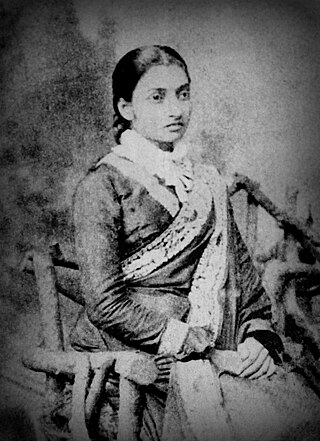
A sari is a women's garment from the Indian subcontinent. It consists of an un-stitched stretch of woven fabric arranged over the body as a robe, with one end attached to the waist, while the other end rests over one shoulder as a stole, sometimes baring a part of the midriff. It may vary from 4.1 to 8.2 metres in length, and 60 to 120 centimetres in breadth, and is a form of ethnic wear in India, Sri Lanka, Nepal, Bangladesh, and Pakistan. There are various names and styles of sari manufacture and draping, the most common being the Nivi style. The sari is worn with a fitted bodice also called a choli and a petticoat called ghagra, parkar, or ul-pavadai. It remains fashionable in the Indian subcontinent today.

Jamdani is a fine muslin textile produced for centuries in South Rupshi of Narayanganj district in Bangladesh on the bank of Shitalakhwa river.
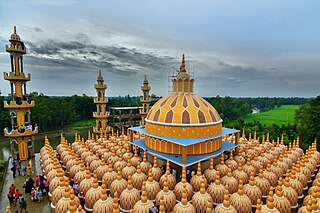
Tangail is a district (zila) in the central region of Bangladesh. In 1969, Tangail district was created by Tangail Mohokuma from its 237 square kilometers of land and 3177 square kilometers of land acquired from Mymensingh district. It is the largest district of Dhaka division by area and second largest by population. The population of Tangail zila is about 4 million and its area is 3,414.28 square kilometres (1,318.26 sq mi). The main city of the district is Tangail. It is surrounded by Jamalpur District on the north, the Dhaka and Manikganj Districts on the south, Mymensingh and Gazipur on the east, and Sirajganj on the west.

Santipur is a city and a municipality in the Ranaghat subdivision of Nadia district in the Indian state of West Bengal. The fort area of this city, also known as Daak-Garh is thought to have been built by Raja Krishnachandra of Nadia.
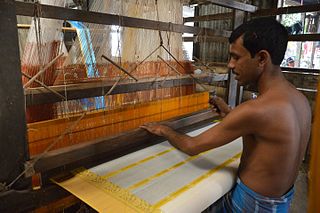
Phulia is a census town in the Santipur CD block of the Ranaghat subdivision in the Nadia district in the Indian state of West Bengal. It is birthplace of 'Adi kavi' of Bengal Krittibas Ojha.
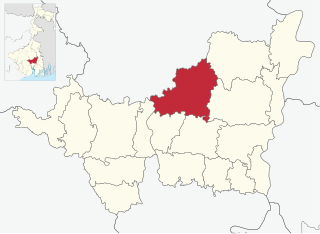
Dhaniakhali is a community development block that forms an administrative division in Chinsurah subdivision of Hooghly district in the Indian state of West Bengal. The place has lent its name to the tant (handloom) sari it produces.
Dhaniakhali is a village in Dhaniakhali CD Block in Chinsurah subdivision of Hooghly district in the Indian state of West Bengal. The place has lent its name to the popular Dhaniakhali Sari.

Baluchari Sari is a type of sari, a garment worn by women in the Indian states of West Bengal, Tripura and Assam and the country of Bangladesh. This particular type of sari originated in West Bengal and is known for depictions of mythological scenes on the anchal of the sari. It used to be produced in Murshidabad but presently Bishnupur and its surrounding areas of West Bengal are the only place where authentic Baluchari saris are produced. It takes approximately one week to produce one such sari. In 2011, the Baluchari Sari was granted the status of Geographical Indication for West Bengal in India.

Tant sari is a traditional Bengali sari, originating from the Bengal region in the eastern part and usually used by Bengali women. Tant sari are woven from cotton threads and distinguished by its lightness and transparency. It is considered to be the most comfortable sari for the hot and humid climate in the Indian subcontinent.
Uppada Jamdani saree is a silk sari style woven in Uppada of East Godavari district in the Indian state of Andhra Pradesh. It was registered as one of the geographical indication from Andhra Pradesh by Geographical Indications of Goods Act, 1999. Uppada Jamdani saris are known for their light weight.

Handloom saris are a traditional textile art of Bangladesh and India. The production of handloom saris is important for economic development in rural India.
The handloom industry in Tangail is one of the oldest cottage industries in Bangladesh. This traditional saree is produced in Tangail district and is named after the place.
Samudragarh is a village in Purbasthali I CD block in Kalna subdivision of Purba Bardhaman district in the state of West Bengal, India. Nadanghat police station serves this village. It is about 15 km away from Kalna, India. It is situated on the western bank of the Bhāgirathi.
Biren Kumar Basak is an Indian handloom weaver from the Nadia district. He is the recipient of Padma Shri, the fourth highest civilian award of India.

Shantipuri sari is a traditional handwoven cotton sari of West Bengal. It is produced in the Shantipur city and surrounding area of Nadia district, West Bengal. Shantipuri handloom sari is famous for the novelty of designs, hand spinning method with extra weft, different color patterns and the thin finesse of the fabric. The fine Shantipuri sari is a highly demanded commodity all over the world. Shantipuri Sari got geographical indications tag in 2009.

Tangail saree is a traditional handwoven saree (Sari) of West Bengal. It is produced in Purba Bardhaman & Nadia districts of West Bengal. These handlooms are famous for the novelty of saree designs, hand-woven booties, use of natural fibers in the weave and saree fineness of the fabric. In 2024, Tangail Saree was recognized as a Registered Geographical indication under the title Tangail Saree of Bengal and Banglar Tangail Saree in Bengali language.
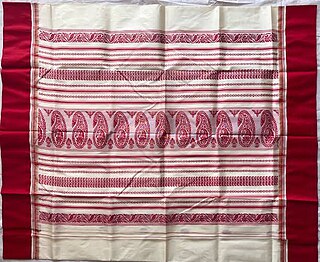
Garad saree is a traditional handwoven saree (sari) of West Bengal. It is produced in Murshidabad and Birbhum districts of West Bengal. Mrityunjay Sarkar, a weaver of Mirzapur, is the inventor of this famous saree. This handloom saree is famous for the beautiful delicate designs on the anchal and "butti", the use of 100% pure silk in the weave and the saree fineness of the fabric. In 2024, Garad Saree received recognition as a Registered Geographical indication.

Korial Saree is a traditional handwoven saree (Sari) of West Bengal. These handloom sarees are famous for the red boarder, novelty of saree designs, beautiful designs on the anchal, and natural fibers in weaving. The saree was the symbol of holiness, purity and good shine. In 2024, the Korial Saree received recognition as a registered Geographical indication.

Shantipur Handloom Industry, also known Shantipur Handloom Cluster, is a handloom weaving industry in Nadia district of West Bengal. It is one of the foremost handloom centers of India. This handloom industry is world famous for the production of cotton Sari (saree). The two main centers of this industrial zone are Shantipur and Phulia. Shantipur has an old reputation for cotton sarees, known as Shantipuri sarees, and Phulia is well known for Tangail-Jamdani sarees.
















